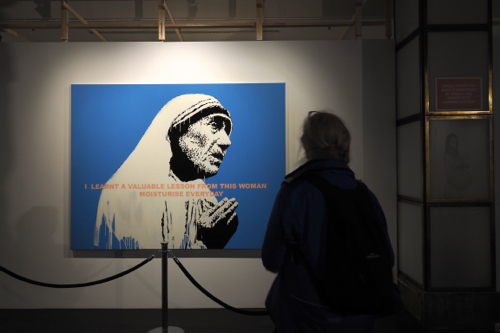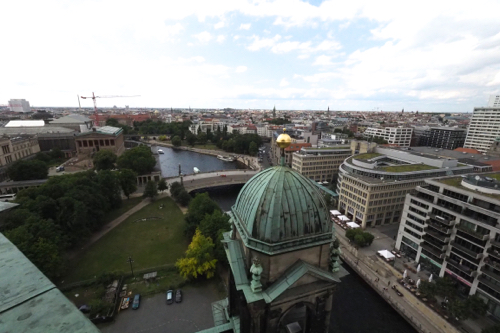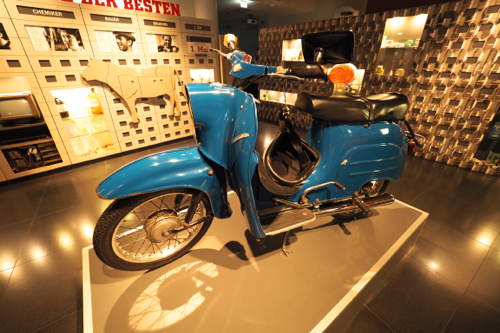June 24, 2017. Berlin, Germany.
Arriving in Zurich we had 20 minutes to make our connection to Berlin.
This involved a change of terminal. We made it with a few minutes to spare, but then had to wait an hour, as there was a discrepancy in the passenger list.
It was a Saturday so Hayden and Andrea picked us up from the airport and took us back to their apartment. We immediately went round the corner for a coffee, which was served to us by an Australian.
In the afternoon we went for a walk in Volkspark Friedrichshain. There were hundreds of Berliners enjoying the large green spaces. There are two ‘hills’ in the park that were once bunkers but are now covered in trees and vegetation.
These are the only relief from what is a rather flat landscape in the Berlin area.
Volkspark Friedrichshain is the oldest park in Berlin and at 52 hectares, the fourth largest. The oldest parts of the park were planted between 1846 and 1848, over the site a former vineyard.
After the Second World War the park was in the Soviet Sector.
June 25, 2017. Berlin, Germany.
On our first ‘awake’ day in Berlin we did the touristy thing and went on a ‘Berlin from Below’ tour.
This one was ‘Subways and Bunkers in the Cold War’. There are five tours that explore the city from a subterranean perspective.
This was the story of how the Western Berliners used old subway tunnels from the 30s’ and new ones from the 80s’ to developed a series of civil defence shelters.
This was the time of the Cold War and both the East and the West were on high alert. They were ever mindful that a nuclear holocaust was just around the corner.
The underlying theme, of the presentation, was a sceptical one. Sceptical in that all the money that was spent on these precautions was really just part of a placebo effect.
It may have made the people of Berlin feel safe, but in effect it was useless.
Only 1% of the inhabitants could be housed in these bunkers. Compare this to the Swiss system of civil defence, where 120% of their population could be saved.
Unfortunately no photos were allowed on the tour – I wonder if there is thought of using these bunkers again.
In the afternoon we went to ‘The Art of Banksy’ exhibition.
This exhibition of Banksy’s work was totally unauthorised, created by his former agent, Steve Lazarides.
They have been estranged for over eight years.
Lazarides didn’t believe that he needed to get permission from the famous street artist, because he knew he wouldn’t get it anyway.
None of the work is ‘off the street’ but rather a collection of work that Banksy made for sale. Lazarides was more than likely the agent who sold the work in the first place.
There was a wide variety of work from screen printing, test images, oil paintings and even sculpture.
The exhibition has already been shown in a number of cities, including Melbourne.
It was not without controversy there, as it was ‘visually attacked’ by Melbourne street artist, Matt ‘Adnate’, two days before the opening.
Rats have always featured in Banksy’s work. When asked by Timeout Magazine in 2010, about his fascination with the rodents, he gave this typically self effacing answer:
“They exist without permission. They are hated, hunted and persecuted. They live in quiet desperation amongst the filth. And yet they are capable of bringing entire civilisations to their knees. If you are dirty, insignificant and unloved, then rats are the ultimate role model. I’d been painting rats for three years before someone said: ‘That’s clever it’s an anagram of art’. And I had to pretend I’d known that all along.”
The irony is, that there is a gift shop at the end of the exhibition.
This goes against everything Banksy stands for.
Late in the day we had a coffee at Oslo Coffee Bar, which is just around the corner from where Hayden works. The coffee is great but what stands out at this cafe is their re-usable, dishwasher safe, coffee cups made from recycled coffee beans.
Created by the product designer Julian Lechner, these unique coffee cups took three years to develop. They were first launched in 2015 and are made from Kaffeeform. This is an entirely new material, that recycles coffee grounds, combines them with a renewable raw material, which is then moulded into espresso, cappuccino and take-away coffee cups.
(To find out more visit: kaffeeform.com)
June 26, 2017. Berlin, Germany.
It was another day devoted to exploring more of Berlin.
Our first stop was at the site of the Führerbunker (Hitler’s Bunker). There is nothing there except a car park. It is certainly not a memorial and everything is done to play down its significance.
The Führerbunker was an air-raid shelter near the Reich Chancellery. Built in two stages, 1936 and 1944, it was designed by Albert Spier and Karl Piepenburg.
Hitler spent the last few weeks of the war here, marrying Evan Braun, shortly before they both committed suicide.
Then, on a more sobering note we visited the Memorial to the Murdered Jews of Europe, which is also known as the Holocaust Memorial.
Inaugurated in 2005, it was designed by architect Peter Eisenman and engineered by Buro Happold. The 19,000 square metre site is covered with 2,711 grey concrete slabs or stelae.
There is believed to be no exact interpretation of the design but I felt the stelae had an erie resemblance to coffins.
It certainly makes you think and it is to be hoped that this thinking and reflection will continue in Germany for an eternity.
We walked from the Jewish Memorial down to the Berlin Cathedral or Evangelical Supreme Parish and Collegiate Church in Berlin.
There has been a church on the site since 1608. The current cathedral was built between 1894 and 1905 during the reign of Kaiser Wilhelm II. It was designed by Julius Raschdorff in the High Renaissance style.
It was extensively damaged during World War II and rebuilt between 1975 and 1993, when it was rededicated. The restoration work wasn’t finally completed until 2002.
To my mind the Berliner Dom is yet another opulent church that’s had far too much money spent on glorifying clergy and monarchs, rather than helping the people of the parish.
June 27, 2017. Berlin, Germany.
There is so much recent history in Berlin – WWII and the rise of the Nazi state, the ‘Final Solution’ resulting in the Holocaust and the DDR rule of Berlin’s Eastern Sector.
We had decided to cover a bit of it all.
The DDR Museum is located on the Spree River, opposite the Berlin Cathedral.
It’s small, crowded and very hands-on, giving the visitor a chance to look at and experience life in the DDR (Deutsche Demokratische Republik)
There are three themed areas. Public Life, State and Ideology and Life in a Tower Block.
The museum was opened in 2006 and was initially privately funded. This was regarded by the public museums as a threat to their funding.
One of the exhibits that caught my attention was of an East German Trabi. This quaint and very basic people mover was produced by VEB Sachsenring Automobilwerke Zwickau from 1957 to 1990.
It was the laughing stock of the big West German auto manufacturers and the butt of many jokes.
One being: How do you double the value of a Trabi? Fill up the tank.
The Trabi wasn’t entirely a dud as it had a plastic body on a monocoque chassis, front wheel drive and independent suspension.
All unusual and contemporary features for a car at that time.
Hayden and Andrea understand my love of craft beer and took us to the BrewDog Craft Brewery.
They had thirty beers on tap, with great names such as Punk IPA, Dead Pony Club, Hop Fiction and at 0.5% Alcohol by Volume, my favourite, Nanny State.
BrewDog have a very alternative view on marketing, they have open-sourced their beer recipes, making them a form of Free Beer.
You won’t find the big brewers doing that.
Despite their punk approach, BrewDog, based in Ellon, Scotland, are an international brewery. They opened in 2007 and now produce bottled and keg beer for local consumption and export. They have bars throughout the UK and also in Stockholm and Gothenburg in Sweden, Helsinki in Finland, Florence in Italy, São Paulo in Brazil and of course Berlin in Germany.
BrewDog also has plans to open a brewery in Brisbane. This means that some of their excellent draught and bottled beers might end up down in Melbourne.
June 28, 2017. Berlin to Frankfurt and Kreuzwertheim, Germany.
The day didn’t go as well as we had planned.
Firstly our plane from Berlin to Frankfurt was an hour late. Then when we went to pick up our Renault Eurodrive lease car – it didn’t have any number plates. They hadn’t come with the car when it was shipped from France.
After many discussions between Michael, the Renault Eurodrive representative and Renault in France, we were taken back to the airport to get an Avis hire car.
This was only after Renault Roadside Assist couldn’t get a car in down-town Frankfurt, as they were all booked out.
They were reluctant to go to the airport depot as they charge a 21.5% surcharge, which wasn’t our concern as they were paying.
At the end of the day we found ourselves driving an Opel Mokka rather than a Renault Captur.
Renault had booked the rental car for ten days. The big question was how quickly could they get our Captur, with number plates, delivered to us.
After all we were heading into Eastern Europe, and moving further and further away from France.












